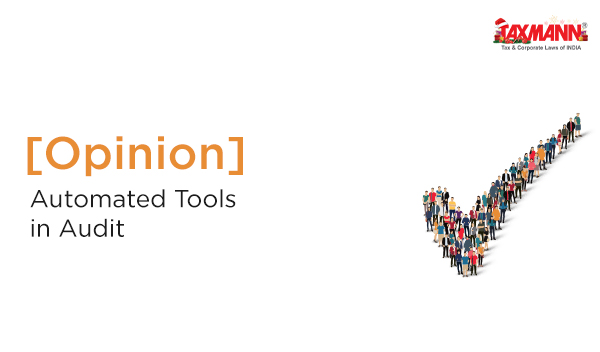[Opinion] Automated Tools in Audit
- Blog|News|Account & Audit|
- 2 Min Read
- By Taxmann
- |
- Last Updated on 27 December, 2023

CA Arpit Gokhroo & Suruchi Khandelwal – [2023] 157 taxmann.com 579 (Article)
Kb tk purane audit process ko use krte rhenge janab, ab toh automation ka zamana hai!!
The era of automation has brought about a revolution in various industries, and the audit sector is no exception. Audit – a vast and very important practice in the world of business and commerce, but don’t you think the process to perform audits is quite monotonous and a lengthy one. So, in this era of automation and technology world, why should we continue the same traditional process of audit? Why not make audit process full of fun and enjoy our work by learning more new things and concepts. With this, introducing you the topic, “Automated tools in Audit”. Gone are the days of tedious manual tasks and sifting through mountains of paperwork.
Let’s first understand about the actual meaning of automated tools.
What are automated tools?
These tools basically refer to the use of technology, software, and computerized systems to streamline and enhance various aspects of the auditing process.
These tools are designed to perform specific tasks or functions traditionally carried out in manual manner by auditors. The goal is to improve efficiency, accuracy, and effectiveness and saving time and cost in the audit function by leveraging the capabilities of technology.
These tools can encompass a range of applications, including:
- data analysis
- risk assessment
- compliance testing, and
- reporting.
You can also think of these as some digital assistant that can extract data from various sources, analyse it with lightning speed, identify patterns and anomalies, and generate insightful reports. In other words, these tools are a game-changer, bring efficiency, accuracy, and deeper insights to the audit profession.
Some examples of these automated tools in audit are Power BI, Audit trail, Internet of things (IOT), CaseWare and many more.
But before studying the practical use of these tools in detail, just think that what was the need of introducing these tools in audit or what are the reasons for automating our traditional techniques of performing audit. Here is the answer to the above thought:

Click Here To Read The Full Article
Disclaimer: The content/information published on the website is only for general information of the user and shall not be construed as legal advice. While the Taxmann has exercised reasonable efforts to ensure the veracity of information/content published, Taxmann shall be under no liability in any manner whatsoever for incorrect information, if any.

Taxmann Publications has a dedicated in-house Research & Editorial Team. This team consists of a team of Chartered Accountants, Company Secretaries, and Lawyers. This team works under the guidance and supervision of editor-in-chief Mr Rakesh Bhargava.
The Research and Editorial Team is responsible for developing reliable and accurate content for the readers. The team follows the six-sigma approach to achieve the benchmark of zero error in its publications and research platforms. The team ensures that the following publication guidelines are thoroughly followed while developing the content:
- The statutory material is obtained only from the authorized and reliable sources
- All the latest developments in the judicial and legislative fields are covered
- Prepare the analytical write-ups on current, controversial, and important issues to help the readers to understand the concept and its implications
- Every content published by Taxmann is complete, accurate and lucid
- All evidence-based statements are supported with proper reference to Section, Circular No., Notification No. or citations
- The golden rules of grammar, style and consistency are thoroughly followed
- Font and size that’s easy to read and remain consistent across all imprint and digital publications are applied



 CA | CS | CMA
CA | CS | CMA
